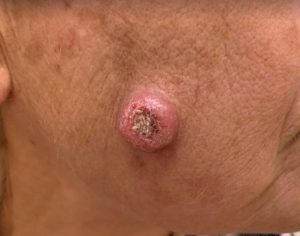Benign skin lesions
The simple pigmented nevi:
During our lifetime, we all develop moles which are simple accumulation of melanocytes in the skin. They have different shapes, different colors, textures and sizes. The majority of cases presents no problem. Exposure to sunlight affects the development of moles. It is very important to have a regular checkup by a qualified doctor. A percentage of malignant melanoma occurs in a pre-existing mole. Any change in size, shape, texture, color is an indication for surgical excision and biopsy.
Congenital nevi can have various colors, irregular surface, hair growth and irregular borders. The size of the relative moles is decisive for their course as the bigger the mole, the more likely it is to become malignant.
Benign papillomas of the skin:
They occur most commonly around the neck and in the folds of the body, armpits, inframammary area, inguinal areas, They are very easily treated with the use of lazer. Because they usually multiply it is recommended that they be treated when they are still small and few in number.
Hyperkeratosis:
They are very common skin lesions that appear all over the body in older people. They can reach a large size, have an irregular berry-like appearance, and often when they are large enough, part of them can break off and bleed slightly. Their treatment consists of simple ‘shaving’ or cryocoagulation of the lesion as they originate from the surface layer of the skin.
Keratoacanthoma (K.A.):
It is a very fast-growing skin tumor, which morphologically has exactly the same appearance as squamous cell carcinoma, but is not malignant. Its exact diagnosis is made by microscopic examination of the tumor, after its removal.
Malignant skin lesions
Skin carcinomas are the most common form of neoplasm in humans (the rate of occurrence in the population over 65 is 40-50%). All forms of skin cancer are due in the majority of cases to the chronic effect of solar radiation. Due to the increased exposure of individuals to the sun over the last 30 years, the incidence rate of all forms of skin cancer is increasing exponentially. Any skin lesion that appears suddenly, or changes in appearance and size, ulcerates or bleeds should be immediately checked by a specialist doctor so that treatment can be done at the earliest possible stages. This helps avoid the need for extensive reconstructive surgeries that are required when these areas are not diagnosed and treated early.
Basal cell skin carcinoma or epithelioma:
It is the most common, simplest and most innocent form of skin neoplasia. It accounts for 80% of skin neoplasms. It is often observed in older people on parts of the body that are often exposed to the sun, face, hands, etc. It usually presents as a small nodule that slowly increases in size, has small neoplastic vessels on its surface, is subdural and can often present ulceration or minor bleeding and does not heal. It is treated with radical surgical excision which leads to a complete cure. It rarely recurs and is treated similarly. No further treatment (radiation or chemotherapy) is needed except for a 6-month check-up by your doctor. Regarding the surgical removal of the epithelial carcinoma if it is small, it is a simple operation with local anesthesia. Rarely in neglected cases it is necessary to repair the deficit left after the removal either with a graft or with local flaps.
Squamous cell carcinoma of the skin:
It usually appears on the parts of the body that are exposed to sunlight, as well as on the inside of the mouth and on the lips, especially the bottom. It presents as a nodule that grows rapidly and often ulcerates. Depending on its size and histological picture, squamous cell carcinoma rarely spreads to local lymph nodes. Most often all that is needed is radical surgical removal of the lesion and frequent follow-up.
Melanoma of the skin:
It is the rarest but also the most serious form of skin cancer. It usually appears in the form of a particularly dark olive which is usually a little more swollen than the surrounding skin. In men it usually appears on the trunk and in women on the extremities. Early detection and diagnosis are critical factors for patient survival. People more likely to develop melanoma are those with multiple moles (olives), large congenital moles (from birth), a family history of multiple atypical moles or melanoma, and finally people with a history of previous prolonged sun exposure and sunburn. Its treatment consists of radical surgical removal, and depending on its histological examination, further treatment may be needed. The treatment of melanoma is best done in specialized plastic surgery centers such as e.g. the mole and melanoma department at G. Gennimatas hospital in Athens.

